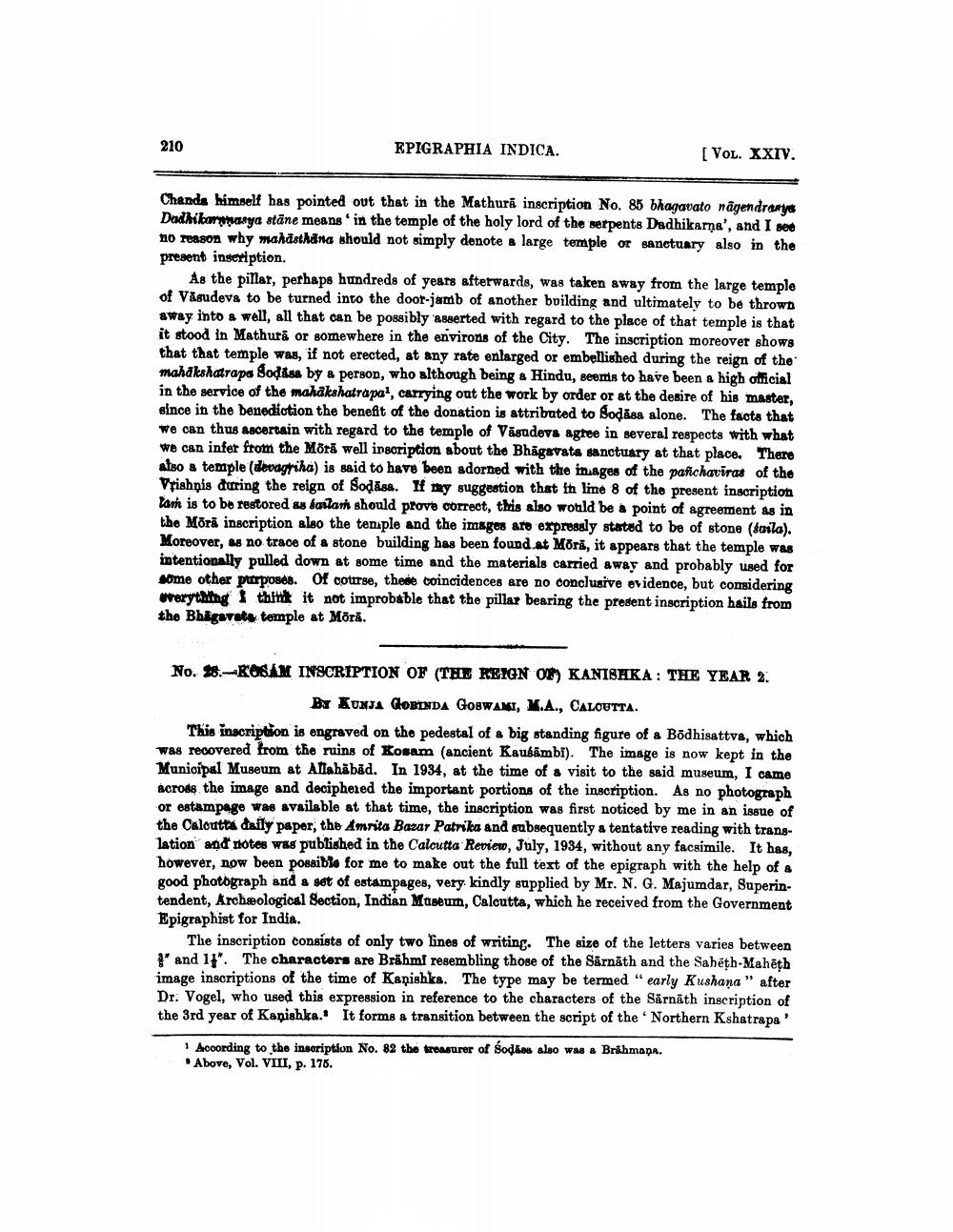________________
210
EPIGRAPHIA INDICA.
[Vol. XXIV.
Chands himself has pointed out that in the Mathurā inscription No. 85 bhagavato nagendrary Dadhikarunarya stāne means in the temple of the holy lord of the serpents Dadhikarna', and I see no reason why mandsthana should not simply denote a large temple or sanctuary also in the present inseription.
As the pillar, perhaps hundreds of years afterwards, was taken away from the large temple of Vasudeva to be turned into the door-jamb of another building and ultimately to be thrown away into a well, all that can be possibly asserted with regard to the place of that temple is that it stood in Mathura or somewhere in the environs of the City. The inscription moreover shows that that temple was, if not erected, at any rate enlarged or embellished during the reign of the mahakshatrapa Sodasa by a person, who although being a Hindu, seems to have been a high official in the service of the mahakshatrapa', carrying out the work by order or at the desire of his master, since in the benediction the benefit of the donation is attributed to Sodasa alone. The facts that We can thus ascertain with regard to the temple of Vasudeva agree in several respects with what we can infer from the Motã well inscription about the Bhagavata sanctuary at that place. There atso a temple (devagriha) is said to have been adorned with the inages of the pafchaviras of the Vrishnis during the reign of Sodasa. If my suggestion that in line 8 of the present inscription tam is to be restored as bailan should prove correct, this also would be a point of agreement as in the Mörā inscription also the teniple and the images are expressly stated to be of stone (faila). Moreover, as no trace of a stone building has been found at Moră, it appears that the temple was intentionally pulled down at some time and the materials carried away and probably used for some other purposes. Of course, these coincidences are no conclusive evidence, but considering
verything I think it not improbable that the pillar bearing the present inscription hails from the Bhagavate temple at Möră.
No. 48.-ROSAM INSCRIPTION OF THE REIGN OR) KANISHKA: THE YEAR 2.
By XUNJA GOBINDA GOSWAMI, M.A., CALOUTTA. This inscription is engraved on the pedestal of & big standing figure of a Bodhisattva, which was recovered from the ruins of Kosam (ancient Kaubambi). The image is now kept in the Municipal Museum at Allahabad. In 1934, at the time of a visit to the said museum, I came across the image and deciphered the important portions of the inscription. As no photograph or estampage was available at that time, the inscription was first noticed by me in an issue of the Caloutta daily paper, the Amrita Bazar Patrika and subsequently a tentative reading with translation and notes was published in the Calcutta Review, July, 1934, without any facsimile. It has, however, now been possible for me to make out the full text of the epigraph with the help of a good photograph and a set of estampages, very kindly supplied by Mr. N. G. Majumdar, Superintendent, Archeological Section, Indian Museum, Calcutta, which he received from the Government Epigraphist for India.
The inscription consists of only two lines of writing. The size of the letters varies between 2 and 11". The characters are Brahmi resembling those of the Sarnath and the Sabeth-Mahēth image inscriptions of the time of Kanishka. The type may be termed "early Kushana" after Dr. Vogel, who used this expression in reference to the characters of the Särnäth inscription of the 3rd year of Kanishka. It forms a transition between the script of the Northern Kshatrapa'
According to the inscription No. 82 the treasurer of sodies also was a Brahmapa. . Above, Vol. VIII, p. 176.




